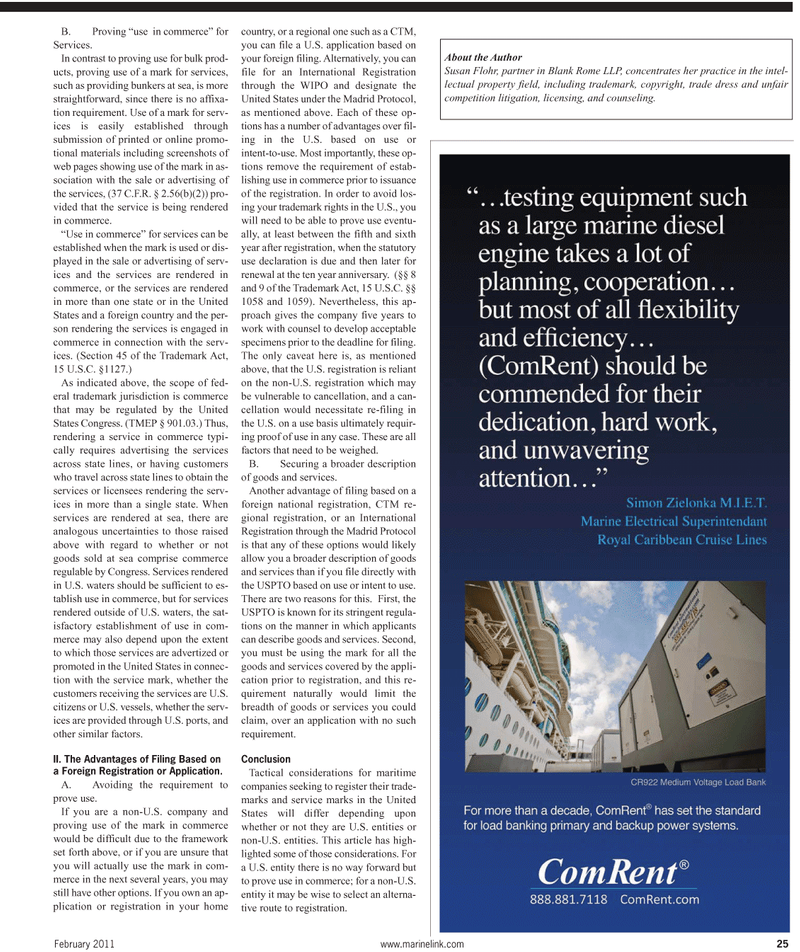
Page 25: of Maritime Reporter Magazine (February 2011)
Cruise & Passenger Vessel Annual
Read this page in Pdf, Flash or Html5 edition of February 2011 Maritime Reporter Magazine
February 2011 www.marinelink.com 25
B. Proving “use in commerce” for
Services.
In contrast to proving use for bulk prod- ucts, proving use of a mark for services, such as providing bunkers at sea, is more straightforward, since there is no affixa- tion requirement. Use of a mark for serv- ices is easily established through submission of printed or online promo- tional materials including screenshots of web pages showing use of the mark in as- sociation with the sale or advertising of the services, (37 C.F.R. § 2.56(b)(2)) pro- vided that the service is being rendered in commerce. “Use in commerce” for services can be established when the mark is used or dis- played in the sale or advertising of serv- ices and the services are rendered in commerce, or the services are rendered in more than one state or in the United
States and a foreign country and the per- son rendering the services is engaged in commerce in connection with the serv- ices. (Section 45 of the Trademark Act, 15 U.S.C. §1127.)
As indicated above, the scope of fed- eral trademark jurisdiction is commerce that may be regulated by the United
States Congress. (TMEP § 901.03.) Thus, rendering a service in commerce typi- cally requires advertising the services across state lines, or having customers who travel across state lines to obtain the services or licensees rendering the serv- ices in more than a single state. When services are rendered at sea, there are analogous uncertainties to those raised above with regard to whether or not goods sold at sea comprise commerce regulable by Congress. Services rendered in U.S. waters should be sufficient to es- tablish use in commerce, but for services rendered outside of U.S. waters, the sat- isfactory establishment of use in com- merce may also depend upon the extent to which those services are advertized or promoted in the United States in connec- tion with the service mark, whether the customers receiving the services are U.S. citizens or U.S. vessels, whether the serv- ices are provided through U.S. ports, and other similar factors.
II. The Advantages of Filing Based on a Foreign Registration or Application.
A. Avoiding the requirement to prove use.
If you are a non-U.S. company and proving use of the mark in commerce would be difficult due to the framework set forth above, or if you are unsure that you will actually use the mark in com- merce in the next several years, you may still have other options. If you own an ap- plication or registration in your home country, or a regional one such as a CTM, you can file a U.S. application based on your foreign filing. Alternatively, you can file for an International Registration through the WIPO and designate the
United States under the Madrid Protocol, as mentioned above. Each of these op- tions has a number of advantages over fil- ing in the U.S. based on use or intent-to-use. Most importantly, these op- tions remove the requirement of estab- lishing use in commerce prior to issuance of the registration. In order to avoid los- ing your trademark rights in the U.S., you will need to be able to prove use eventu- ally, at least between the fifth and sixth year after registration, when the statutory use declaration is due and then later for renewal at the ten year anniversary. (§§ 8 and 9 of the Trademark Act, 15 U.S.C. §§ 1058 and 1059). Nevertheless, this ap- proach gives the company five years to work with counsel to develop acceptable specimens prior to the deadline for filing.
The only caveat here is, as mentioned above, that the U.S. registration is reliant on the non-U.S. registration which may be vulnerable to cancellation, and a can- cellation would necessitate re-filing in the U.S. on a use basis ultimately requir- ing proof of use in any case. These are all factors that need to be weighed.
B. Securing a broader description of goods and services.
Another advantage of filing based on a foreign national registration, CTM re- gional registration, or an International
Registration through the Madrid Protocol is that any of these options would likely allow you a broader description of goods and services than if you file directly with the USPTO based on use or intent to use.
There are two reasons for this. First, the
USPTO is known for its stringent regula- tions on the manner in which applicants can describe goods and services. Second, you must be using the mark for all the goods and services covered by the appli- cation prior to registration, and this re- quirement naturally would limit the breadth of goods or services you could claim, over an application with no such requirement.
Conclusion
Tactical considerations for maritime companies seeking to register their trade- marks and service marks in the United
States will differ depending upon whether or not they are U.S. entities or non-U.S. entities. This article has high- lighted some of those considerations. For a U.S. entity there is no way forward but to prove use in commerce; for a non-U.S. entity it may be wise to select an alterna- tive route to registration.
About the Author
Susan Flohr, partner in Blank Rome LLP, concentrates her practice in the intel- lectual property field, including trademark, copyright, trade dress and unfair competition litigation, licensing, and counseling.

 24
24

 26
26
